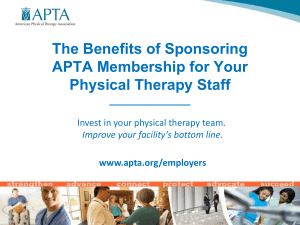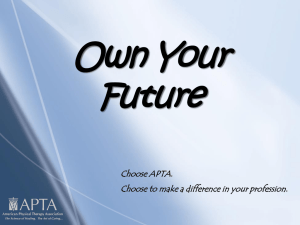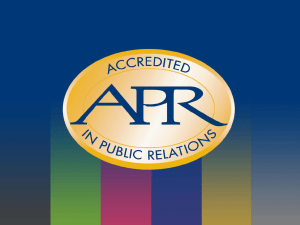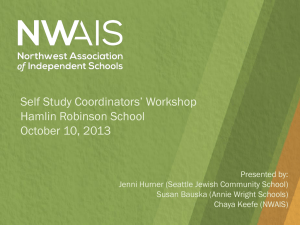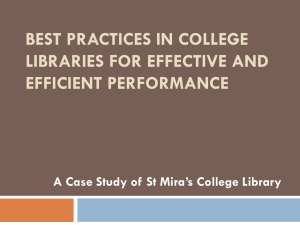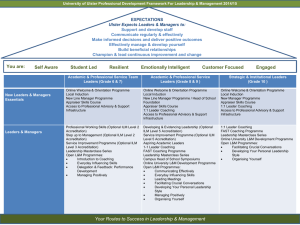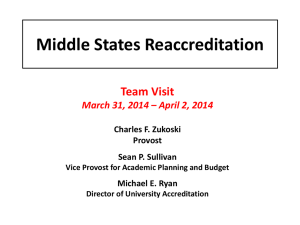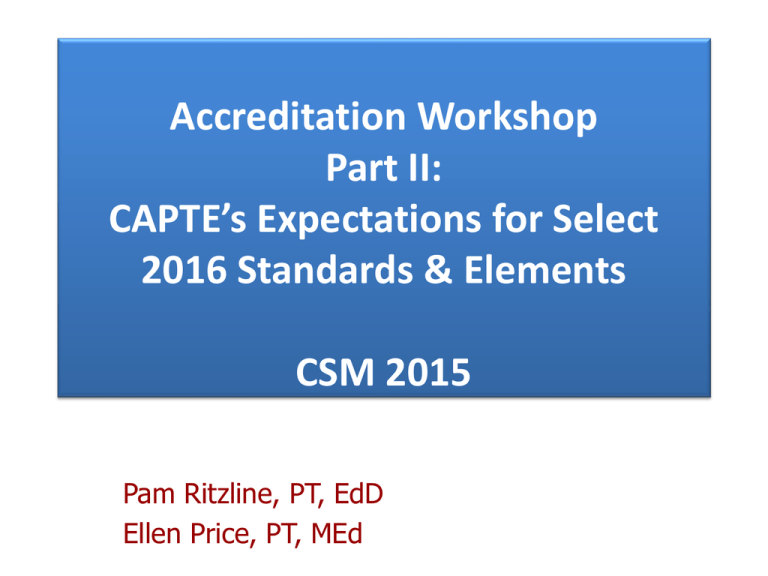
Accreditation Workshop
Part II:
CAPTE’s Expectations for Select
2016 Standards & Elements
CSM 2015
Pam Ritzline, PT, EdD
Ellen Price, PT, MEd
Purpose of Workshop
Describe CAPTE’s Expectations
Provide Hints
Answer Questions
Encourage Self-study Process
1/10/15
©APTA Department of Accreditation
2
Keep in Mind
Provide ALL documentation
using most current AFC/SSR
Never use SSR documents
for an AFC
* Follow Instructions,
including naming files
1/10/15
©APTA Department of Accreditation
3
Be Careful What You Write
Did they really mean that?
• The faculty have made the following change to
program policies in order to ensure students
are prepared for clinical experiences:
– Eliminated safety, professional behavior and
communication from the policy; keeping
knowledge and adding, ‘and successfully
completed all previously required courses in the
curriculum’.
1/10/15
©APTA Department of Accreditation
4
Be Concise But Provided Requested
Detail
1/10/15
©APTA Department of Accreditation
5
Most Frequently Cited Criteria:
Do It Now or Do It Later….
Candidacy: Bold = ≥ 20%
expected outcomes
assessment
core faculty expertise
scholarship
qualified PD
faculty assessment
associated expertise
Philosophy
organized curriculum
behavioral objectives
curriculum evaluation
clin ed evaluation
foundational science
clin ed
Curric content: fiduciary
1/10/15
Continuing: Bold = ≥ 20%
assessment
long term planning
core faculty expertise
scholarship
qualified PD
sufficient # core faculty
associated expertise
behavioral objectives
Meeting expected outcomes
©APTA Department of Accreditation
6
2016 Standards
1
2
3
4
5
6
7
8
1/10/15
Mission, Goals, & Outcomes
Assessment, Planning
Institution & Program Integrity
Program Faculty
Students
Curriculum Plan
Curricular Content
Resources
©APTA Department of Accreditation
New
Elements
7
2016 Standards
• Standards includes Narrative Evidence List
• Appendices: Not listed in Standards
– Included in instructions / Forms Packet
– An item is listed only once
• Identification of all related Elements
• Portal: Must attach item to each related Element
• Portal: Must name file as instructed
• On-site Material also listed only in
instructions/forms packet
1/10/15
©APTA Department of Accreditation
8
Preface:
Serves as Intro to AFC/SSR
SSR:
•
Brief historical overview of the program
AFC:
• Describe process & information used to determine the need
for the program, including summary of needs assessment
• On-site: actual needs assessment
• Identify # students per class & planned timelines to admit
each cohort
• Describe contingency plan for students if program should fail
to achieve accreditation status, including how & when this
plan is communicated to prospective students
1/10/15
©APTA Department of Accreditation
9
Standard 1
The program meets graduate achievement measures
and program outcomes related to its mission and
goals.
1A Mission
1B Goals
1C Student Achievement & Program Outcomes
1C1 Graduation Rates
1C2 Licensure Pass Rates
1C3 Employment Rates
1C4 Entry-level Performance
1C5 Graduate Outcomes
1C6 Other Program Outcomes
1/10/15
©APTA Department of Accreditation
10
Interrelationship Between
Standard 1 Elements
Mission
Goals
Outcomes
1/10/15
©APTA Department of Accreditation
11
Program Mission & Goals
1A
1B
1/10/15
• Mission of program is written & compatible with
mission of institution & unit
• Expectation: reflects activities and visa versa
• Documented goals based on mission
• Reflect contemporary PT education, research &
practice
• Goals are general statements of desired results
that reflect what program is about
• Not just graduate or student outcomes
• Typically not the same as long term planning
12
goals ©APTA Department of Accreditation
Student Achievement Measures
(required by USDE)
1C1 Graduation Rate
• At least 80% averaged over 2 years
• % matriculated in 1st term after drop/add period & who
completed program
1C2 Licensure Pass Rate
• At least 85% averaged over 2 years
• % grads who take & pass NPTE, regardless of # of
attempts
1C3 Employment Rate
• At least 90% averaged over 2 years
• Of those who sought employment that were employed
within 1 year following graduation
1/10/15
©APTA Department of Accreditation
13
1C1-1C3
Graduation, Licensure &
Employment Rate (SSR)
If admit more than 1 cohort/year, the 2-year rate for
each cohort must meet the expectation of the Element.
If 2 year data is not available, the 1 year rate must be
sufficient to allow program to meet expected 2-year rate
Initial Accreditation:
•
•
Indicate no graduates & provide timeline to collect
1C1 Appendix: Retention Rate Table (Forms Packet)
Licensure Pass Rate:
• Provide most current 2 year data for stabilized data
•
On-site: FSBPT reports
• Also provide 1st time rate
• If students don’t routinely take FSBPT exam, provide equivalent data
1/10/15
©APTA Department of Accreditation
14
1C1-1C3
If Rate Is Below Threshold
or Trending Downward
• CAPTE Expects:
– Thorough and timely assessment of all possible causes
(assessment addressed in 2B1-2B5)
– Identification of strategies consistent with identified
factors contributing to performance deficits
– Timeline for changes to effect outcomes
– Timeline to reassess if changes are effective
• CAPTE reviews student achievement data from
AAR & FSBPT reports
– Don’t delay addressing a decrease in student
achievement as could effect accreditation status
1/10/15
©APTA Department of Accreditation
15
1C4
Students Demonstrate EntryLevel Performance Prior to Graduation
• Not explicit in current Criteria but was expected
• Describe mechanisms used to determine entry-level
performance prior to graduation
• Initial Accreditation: See §8.12 (d) of Rules
– Provide timeline to collect & analyze data for charter class
– No later than 30 days prior to CAPTE meeting, provide:
• List of placements/type of experience for each student
• Copy of summary page of each student’s most recent
evaluation (midterm or final)
• Analysis of student performance in clin ed, in
aggregate, based on CI feedback
1/10/15
©APTA Department of Accreditation
16
1C5
Program Graduates Meet Expected
Outcomes (EO) Defined By Program
• For each goal (in 1B) related to graduates, list
expected outcomes that support the goal
Grad
Outcomes • For each outcome, identify expected level of
achievement
Analysis
• Describe process used to determine if
expectation(s) have been met
• Provide summary data from stakeholders (2C)
• On-site: summary of graduate data collected past 2 years
• Provide analysis of extent graduates meet EOs
Initial
• Respond to first two bullets
Accred
& AFC • Provide timeline to collect & analysis data
1/10/15
©APTA Department of Accreditation
17
1C6
Program Meets Expected
Outcomes (EO)Related to its Mission & Goals
• For all other 1B program goals, list the expected
Other
outcome(s) that support the goal
Program
Outcomes • For each outcome, identify expected level of
achievement
Analysis
• Describe process used to determine if expectation(s)
have been met
• Provide summary data from stakeholders (2C)
•On-site: summary of data collected past 2 years
• Provide analysis of extent program meets its EOs
related to mission & goals
Initial
• Respond to first two bullets
Accred
& AFC • Provide timeline to collect & analysis data
1/10/15
©APTA Department of Accreditation
18
For Multiple Cohorts:
Evidence Outcomes Are Comparable
Cohort
B
Cohort
Cohort
A
C
Comparable
1C1-1C6
Outcomes
1/10/15
©APTA Department of Accreditation
19
Meeting Program Mission
• Direct tie to Goals
Expected
Outcomes (1C) • If meeting, then meeting Goals
Goals (1B)
Mission (1A)
1/10/15
• Direct tie to Mission
• Is met if Goals are met
©APTA Department of Accreditation
20
APTA Outcome Assessment Resource
Outcome Assessment in Physical Therapy Education
At: http://www.apta.org/OutcomesAssessment/
CAPTE does NOT require programs to use this
document
(Position Paper: External Influences on the
Evaluative Criteria)
1/10/15
©APTA Department of Accreditation
21
Standard 2
The program is engaged in effective, on-going, formal,
comprehensive processes for self-assessment and
planning for the purpose of program improvement
2A Ongoing, Formal Assessment Process
2B Assessment of:
2B1 Admission
2B4 Resources
2B2 Enrollment
2B5 Policies
2B3 Faculty
2C Curriculum Assessment
2D Planning
1/10/15
©APTA Department of Accreditation
22
2A
Program
Has
Documented
&
ss
Implemented Ongoing, Formal, &
Comprehensive Assessment Processes
Processes are designed to determine program
effectiveness and used to foster program
improvement
Narrative:
• Describe overall process that summarizes the information in
the program assessment matrix
• Describe overall strengths & weaknesses identified through
analysis of cumulative data (SSR)
• Provide 2 examples of changes in last 4 years, include
rationale, how resulted in program improvement; & timeline
1/10/15 to reassess (SSR)
©APTA Department of Accreditation
23
2A
Assessment Matrix in Appendix
• Intended to provide an outline of process
• Must:
• Use the matrix found in Forms Packet
• Name the File: Assessment Matrix.pdf
• On-site evidence:
• Minutes of meetings where assessment is discussed
• Summary of assessment data collected in the last 4
years
1/10/15
©APTA Department of Accreditation
24
2B1-2B5
Assessment Process Is Used To
Determine Extent To Which The Following Meet Program Needs
Admission process, criteria & prerequisites
Program enrollment appropriately reflects available
resources, program outcomes & workforce needs
new
Collective core, associated & clinical education
faculty
Resources meet, & will continue to meet, current
& projected needs
Program policies & procedures, as well as
relevant institutional policies & procedures
1/10/15
©APTA Department of Accreditation
25
2B
Assessment for Each
Element (2B1-2B5) Includes
Analysis of data & conclusions re: extent
meeting needs; onsite: summary data last 4 yrs
Don’t
delay
If any student achievement or expected outcome
falls below required or expected levels, provide:
Documentation of process to assess and
address deficit
Identification of data collected, conclusions
reached & changes made
Timeline to implement, to meet Element, &
to reassess effectiveness of change(s)
1/10/15
©APTA Department of Accreditation
26
P-14: Policies, Procedures
& Practices
Assess if policies:
• Meet program needs (AFC & SSR)
• If practice matches policy (SSR)
Students
•
•
•
•
•
Admissions
Orientation
Retention/dismissal
Clinical program
Graduation
1/10/15
Faculty – core and
associated
• Workload
• Mentoring /
development
• Evaluation
©APTA Department of Accreditation
Program
• Curriculum:
development;
assessment
• Faculty practice, if
applicable
• Scholarship
• Service/outreach
27
2C
Curriculum Assessment
Written & ongoing process that:
Addresses individual courses and curriculum
as a whole
Includes assessment of clinical education; at
the least: #, variety, length & placement
Considers changing roles & responsibilities
Uses data from stakeholders to
determine strengths & weaknesses
1/10/15
©APTA Department of Accreditation
28
2C
Assessment of
Curriculum (AFC & SSR)
Evidence List for SSR is entire list; AFC: just items in red font
• Describe how considers changing roles & dynamic nature of
profession & health care
• Provide evidence includes assessment of Elements 6A-6M
• Identify stakeholders & process
• Provide summary of most recent evaluation including clin ed
• Describe changes within last 4 yrs with rationale for changes
• Appendix
– Data collection instruments (eg., alumni & employer surveys)
– Curriculum Assessment Matrix (in Forms Packet)
• On-site:
– Summary of data collected in past 4 years
– Meeting minutes in which curriculum is addressed
1/10/15
©APTA Department of Accreditation
29
2C
Clin Ed Assessment Cited
When Not Comprehensive (AFC & SSR)
Formal & ongoing process
Uses data from multiple sources
Not just student assessment of clinical site
Addresses all components of clinical education
AFC & SSR: Describe assessment
SSR: Summary results; changes, assessment tools used
1/10/15
©APTA Department of Accreditation
30
2C
Expect Multi-Faceted
Clin Ed Assessment (AFC & SSR)
Curriculum
Documents
Clin Ed
Faculty
• Placement
• Correspondence
• Clinical
competence
• Length
• Handbooks
• Assessment
Tools
• Teaching
Effectiveness
• Effective use
of assessment
tool
Clinical
Sites
Communication
•Frequency
• Degree
practice meets
program’s
expectations
• Sufficient #
Sites
•To all involved:
•CCCEs,
•CIs
•Students
•Core faculty
• Sufficient
Variety
1/10/15
©APTA Department of Accreditation
31
2A-2B5
Citations Occur
When
Not comprehensive
Informal process or not ongoing
No analysis of data
No relationship between data & analysis
On-site evidence doesn’t support conclusions
No plans to address weaknesses
1/10/15
©APTA Department of Accreditation
32
2D
Strategic Planning
Program has implemented a strategic plan that guides
its future development. The plan takes into account
program assessment results, changes in higher
education, the health care environment and the nature
of contemporary physical therapy practice
Expect:
1. Formal process with core faculty involvement that meets
program’s needs
2. Long-term planning (3-5 years)
3. Planned activities tied to needed resources
4. On-site evidence that process is ongoing
•
•
1/10/15
Planning documents
Minutes of meetings in which strategic planning is discussed
©APTA Department of Accreditation
33
2D
Long-Term Planning
Definition:
• Exercise aimed at formulating a long-term plan to
meet future needs that are usually determined by
extrapolation of present or known needs. It begins
with the current status and charts a path to
projected status. Generally includes short-term plans
for achieving interim goals.
• Long-term planning goals are NOT typically the same
as program goals delineated in 1B
Adapted from: http://www.businessdictionary.com/definition/long-termplanning.html#ixzz3MOZEYgG7
1/10/15
©APTA Department of Accreditation
34
Standard 3
The institution and program operate with integrity
3A
3B
3C
3D
3E
3F
3G
3H
1/10/15
State Authorization
Institutional Accreditation
Policies: Workload & Academic Standards
Policies: Nondiscrimination
Policies: Faculty & Staff
Policies: Outside of Due Process
Policies: Compatibility
Policies: Accreditation Compliance (3H1-3H5)
©APTA Department of Accreditation
35
3A
State
Authorization
3B
• Institution authorized under applicable state law or
other acceptable authority to provide post
secondary education
• Has degree granting authority
• Approved to offer the program
•
3B
New narrative evidence: indicate if institution has authorization to
provide clinical education experiences in other states, where
required
Institutional Accreditation
• Institution is accredited by regional accrediting
agency recognized bye USDE or Council for Higher
Education Accreditation (CHEA)
1/10/15
©APTA Department of Accreditation
36
3A & 3B AFC
Now Require With Initial
Notification of Intent to Develop Program
•
•
•
•
Institution of higher education with degree granting authority
* State approval to offer program/degree
* Regional accreditation by agency recognized by USDE or CHEA
Institution deemed by its accrediting agency to be in compliance with all
accreditation requirements
• Has, or has applied for, approval from institutional accreditor to offer
program
• For Private Institutions: USDE Financial Responsibility Composite Score
above 0
* If approval to offer program is not needed: statement to that effect on
letterhead of agency is required!
Effective 12/2/2014, institutions that have not submitted an Application for
Candidacy will be required to provide the information noted in §7.10(c)(2) no
later than March 1, 2015.
1/10/15
©APTA Department of Accreditation
new
37
3C
Policies: Workload & Academic
Standards (1 of 2)
Institution’s application of policies recognizes
program as professional and academic discipline
CAPTE is looking for evidence:
• Institution supports professional judgment
• Of how roles and workload expectations take
needs into consideration
• Contact hours vs credit hours
• Scholarship; maintain clinical expertise
• Reduction in teaching load for administrative
functions
1/10/15
©APTA Department of Accreditation
38
3C
Policies: Workload & Academic
Standards (2 of 2)
Portal Fields on Faculty Detail Page for EACH person:
• Faculty workload data includes:
• Contact hours/term
• % time spent in listed areas
• Use consistent formula across faculty to determine %s
• Explain any inconsistencies
• PT AFC: for first year of curriculum
• Identify responsibilities in the Qualification box
Portal Fields on Course Detail Page for EACH course:
• Identify faculty & their role for each course
1/10/15
©APTA Department of Accreditation
39
3D -3H5
Policies
3D Policies: equal opportunity and nondiscrimination for faculty,
staff, and prospective/enrolled students
3E Policies: faculty & staff
3F Policies: handling complaints outside of due process, including
prohibition of retaliation following complaint submission
3G Program policies are compatible with institutional policies &
applicable law
3H Policies: maintaining accreditation compliance (3H1-3H5)
CAPTE’s expectations:
•
Policies are written, disseminated, and applied consistently &
equitably.
• Policy for complaints outside due process has to be
available, doesn’t have to be published
• Can be program or institutional policies
•1/10/153H1-3H5 can be in program
director’s
©APTA Department
of Accreditationjob description
40
Standard 4
The program faculty are qualified for their roles and
effective in carrying out their responsibilities
4A Core: Qualifications
4H Clin Ed Coordinator: Qualifications
4B Core: Scholarship
4J Clin Ed Coordinator: Effective
4C Core: Services
4K Collective Faculty: Blend
4D Associated: Qualifications 4L Collective: Academic Regulations
4E Core: Assessment
4M Collective: Curriculum
4F Associated: Assessment
4N Collective: Determine Readiness
4G PD: Qualifications
4O Clin Ed Faculty
4H PD: Effective Leadership
1/10/15
©APTA Department of Accreditation
41
Definitions: Core versus
Associated Faculty
Core
Associated
Employed primarily in entry
level program
Includes program
administrator & ACCE/DCE
Responsibility & authority
for curriculum
Typically F/T but can be P/T
Adjunct & supportive
faculty
Anyone who is NOT core or
clin ed faculty
Can include those with F/T
appointments in unit
1/10/15
©APTA Department of Accreditation
42
4A
Individual Core Faculty
Qualifications (AFC & SSR)
Each core faculty member has:
• Doctoral preparation
new
• Effective 1/1/2020; unless enrolled in academic doctoral program, in
which case extended to 12/31/2025)
• License as PT in jurisdiction where program exists, if teaching
PT clinical content
• Contemporary expertise in assigned areas
• Demonstrated effectiveness in teaching & student evaluation
AFC: Applies to faculty implementing 1st year of
curriculum
1/10/15
©APTA Department of Accreditation
43
Part of Core or Associated Faculty Detail Page
Upload
4A narrative response
goes here
1/10/15
©APTA Department of Accreditation
44
4A
Contemporary
Expertise (AFC & SSR)
• Identify courses & content responsible for; include:
• Prefix, #, title, content assigned, role in course
• Provide specific content expertise directly related to assigned
content (Key word! contemporary expertise)
• Identify education pertinent to content
• If academic preparation is not evident, describe how expertise was/will
be obtained; refer to evidence list
• For clinical courses, describe relevant clinical experiences including
dates of practice; be specific
• See Evidence of Compliance List for other ways to demonstrate
• Additional evidence provided through CVs, syllabi, exams, &
on-site course materials
• CV: CAPTE format required; in Forms Packet
1/10/15
©APTA Department of Accreditation
45
4A
Citations
Can Occur When
Teaching basic science or medical science courses without
any apparent advanced education in content areas
Narrative only discusses general qualifications; i.e.: # yrs in
practice/as faculty, previous courses taught, general
practice settings
On-site review suggests not effective in teaching or
evaluation of student performance
Board certified but no evidence of staying current
1/10/15
©APTA Department of Accreditation
46
4B
Scholarship: Individual Core
Faculty (AFC & SSR)
Each core faculty member has well-defined, ongoing
scholarly agenda that reflects contributions to:
1. Development of new knowledge; OR
2. Critical analysis & review of knowledge or creative
synthesis of insights; OR
3. Application of findings; OR
4. Development of critically reflective knowledge
about teaching and learning; OR
5. Identification/resolution of pressing social, civic or
ethical problems (scholarship of engagement)
1/10/15
©APTA Department of Accreditation
47
4B
Required
Documentation (AFC & SSR )
Narrative
Appendices:
Uploaded
Core Faculty
Detail Page
1/10/15
• Description how agendas fit within
context of program or institution
mission & expected outcomes
• Core Faculty Scholarship Form
• CV
• Both found in forms Packet
©APTA Department of Accreditation
48
4B
CAPTE
Is Looking For (AFC & SSR)
Connections
Accomplishments
Planned Activities
1/10/15
• Between components of agenda
•
•
•
•
That are representative of scholarship
Approximately 5 products / last 10 years
Complete citations – avoid abbreviations
Initial Accreditation – same expectation
which means cannot wait
• Goals
• Targeted venues for dissemination
• Timelines for dissemination (next 4 yrs)
©APTA Department of Accreditation
49
4B
Format Example of
Presentation with Abstract Citation
Hinman MR, Price E: How to keep your sanity
while writing a self-study report. Presented at
the American Association of Educational
Lunatics Annual Meeting, Loco, NM, 2006.
Abstract published in the Archives of Nutty
Professors, 6(3):15, 2011.
1/10/15
©APTA Department of Accreditation
50
4D
Associated Faculty
(AFC & SSR)
If you use them, CAPTE looking for:
• Contemporary expertise related to teaching responsibilities
• Teaching effectiveness
• Information on all individuals involved in a course
– Regardless of terminology used: guest lecturers, adjuncts, support
• IF involved in 50% or > of course contact hours:
– Add to faculty list on Portal, which creates Associated Faculty Detail
Page
– Provide CV (Forms Packet)
– Qualifications field: same information as for core faculty!
• If in <50% of course content hours, use 4D Portal field:
– Name, credentials, applicable course #/name; total contact hours;
content taught, contemporary expertise in content taught
1/10/15
©APTA Department of Accreditation
51
4E & 4F
4E
Core
4F
Evaluation of Faculty
(AFC & SSR)
• Formal evaluation in manner & timeline consistent with
institution policy
• Includes teaching, scholarship, service & any additional
responsibilities
• Results in organized faculty development plan linked to
individual’s assessment & program improvement
• Regular evaluation of associated faculty
• Results in plan to address identified needs.
Associated
AFC: Process
SSR: Process & Recent examples of development
activities
1/10/15
©APTA Department of Accreditation
52
4G
Program Director
Qualifications (AFC & SSR)
Physical therapist
Licensed to practice in state where program is located
*Earned academic doctoral degree; if currently OK can seek waiver
Rank of: Professor or Associate Professor (clinical track OK)
Minimum of 6 years higher ed experience; 3 years F/T in PT Program
1/10/15
©APTA Department of Accreditation
53
4H
Program Direct Effective
Leader (AFC & SSR)
Provides effective leadership for program
including, but not limited to:
•
•
•
•
•
Communication
Program assessment & planning
Fiscal Management
Faculty Evaluation
See Standards for additional items effective
leadership might relate to
1/10/15
©APTA Department of Accreditation
54
4I
Clinical Education
Coordinator (AFC & SSR)
PT
Licensed to practice in state where program is located
Minimum 3 years F/T post licensure clinical practice
• Two years of clinical experience must include experiences
as CCCE or CI, OR
• Minimum of 2 years experience teaching, curriculum
development & administration in a PT education program
1/10/15
©APTA Department of Accreditation
55
4J
Clinical Education
Coordinator (AFC & SSR)
Is effective in developing, conducting, and
coordinating the clinical education program
• Describe process to assess effectiveness
• Describe effectiveness in planning, developing, coordinating,
& facilitate clin ed program
• Organizational, interpersonal, problem solving,
counseling skills
• Ability to work with CCCEs & CIs to address diverse
student needs
• See Standards for additional requested data
1/10/15
©APTA Department of Accreditation
56
4K
Collective Academic
Faculty (AFC & SSR)
• Collective core & associated faculty include an
effective blend of individuals with:
– At least 50% of core holding an earned academic
doctoral degree
• If necessary, provide detailed plan
– Individuals with clinical specialization
– Blend sufficient to meet goals and expected
outcomes related to mission, institutional
expectations & assigned responsibilities
1/10/15
©APTA Department of Accreditation
57
4L-4M
Collective Core Faculty
Responsibilities (AFC & SSR)
4L: Initiate, adopt, evaluate & uphold academic
regulations related to:
• Admission requirements, clinical education program,
grading policy, minimum performance levels, including
professional & ethical behaviors & student progression
4M: Primary responsibility for curriculum
1/10/15
©APTA Department of Accreditation
58
4N
Collective Core
Faculty (AFC & SSR)
• Determine each student’s readiness to engage in
clinical education, including review of:
– Performance deficits
– Unsafe practices of students
• CAPTE looking for:
– Mechanisms used (SSR) or planned mechanisms (AFC)
to make this determination
• How ensure students are prepared to be safe
• Expect program to not send into clinic if know will fail
– On-site evidence of faculty discussions
1/10/15
©APTA Department of Accreditation
59
4O
Clinical Education
Faculty (AFC & SSR)
CIs are licensed PTs, with a minimum of 1 year of F/T (or
equivalent) post-licensure clinical experience & are effective role
models & teachers
• Describe how determines CIs are meeting expectations, including:
• Program’s expectations for clinical competence
• Clinical teaching effectiveness
• Describe program’s expectations for clinical teaching effectiveness
• If not using Web CPI, identify how trained to use tool
• Describe how determine if tool used correctly
• For CIs who provided at least 160 hrs instruction to same student last
academic year, summarize:
• CI qualifications
• Teaching effectiveness, including ability to assess & document
student performance
1/10/15
©APTA Department of Accreditation
60
Standard 5
The program recruits, admits & graduates students
consistent with the missions and goals of the
institution & program and consistent with societal
needs for physical therapy services for a diverse
population
5A
5B
5C
5D
5E
1/10/15
Policies: Recruitment & Admission
Provided Relevant Info
Enrollment Agreements
Policies: Students
Policies: Retention & Progression
©APTA Department of Accreditation
61
5A
Student Policies, Procedures, &
Practices (AFC & SSR)
• Recruitment & Admission
– Appropriate, equitable, applicable law
– Written & available to prospective students
– Designed to enhance diversity of student body
• Narrative
– Planned class size (AAR) and rationale
• How ensure maintain planned size
– Recruitment procedures
• Efforts to recruit diverse student body
– Admission criteria & procedures
• How ensure applied equitably
– Process to determine transfer credits
1/10/15
©APTA Department of Accreditation
62
5B
Student Policies, Procedures, &
Practices (AFC & SSR)
Prospective & enrolled students provided relevant
information that is comprehensive, current and timely
• Element contains list of what at a minimum must be provided
• Includes process for filing complaint with CAPTE
• MUST be on website:
• Student Achievement Data (Accredited Programs)
– Graduation, Licensure & Employment Rates
– Currently 3 years of data; as of 1/2016, 2 years
– Must be most current & identify the years!
• Required accreditation statement (AFC & SSR)
– On each relevant webpage for developing programs
1/10/15
©APTA Department of Accreditation
63
5C-5E
Student Policies,
Procedures, & Practices (AFC & SSR)
5C
• Enrollment Agreements
• Only after disclosure (see list) & admission
5D
• Rights, responsibilities, safety, privacy,
dignity of program students
5E
• Retention & progression policies
• Support diverse student body
• Check for inconsistencies
Website
• Check for accuracy & complete content
1/10/15
©APTA Department of Accreditation
64
Standard 6
The program has a comprehensive curriculum plan
6A Based on Contemporary documents
6B Enter BS Degree or Upper Division Coursework
6C Specific Prerequisites
6D Curriculum Model
6E Organization
6F Interprofessional Education
6G Course Syllabi
6H Course Objectives
6I Instructional Methods
6J Evaluation Methods
6K Distance Education
6L Clinical Education
6M Length
6N Degree
1/10/15
©APTA Department of Accreditation
65
Standards 6 & 7
Initial
Accreditation
**Decision Based On:
• Program experienced by charter class
• ALL responses, syllabi & exams must be for charter class
• Includes all 7D responses
If there have been changes:
• Provide summary/rationale in 2C for changes
• As 2C Appendix: Provide revised syllabi/exams
• File name MUST include: Revised and class of
• S_PT999 Revised Class of 2015
• If insufficient space to provide 7D response for both charter &
current, upload as an appendix the current response
1/10/15
©APTA Department of Accreditation
66
6A
Curriculum Plan
(AFC & SSR)
Based on
CAPTE
Looking For:
1/10/15
• Contemporary Practice
• Standards of Practice
• Current Literature
• Faculty to use contemporary
documents in developing and
revising curriculum plan
• Describe how use each of the above
©APTA Department of Accreditation
67
6B
Prerequisites:
Breadth & Depth (AFC & SSR)
Students enter professional program with a BS
degree. Alternatively, may have 3 years undergrad
education that includes upper division study in 1 area
comparable to a minor at the institution
CAPTE Looking For:
• If require BS, only need to state that
• If don’t require BS, evidence that ALL students enter with
upper division courses in at least 1 discipline equivalent to a
minor at your institution
• Even when this is your alternate model
1/10/15
©APTA Department of Accreditation
68
6C
Prerequisites:
Specific Courses (AFC & SSR)
Specific prerequisite course work is determined by
program’s curriculum plan
CAPTE Looking For:
• Identification of specific prerequisite courses
• Rationale for inclusion of these courses, including expected
entry knowledge & skills
• Analysis of adequacy of prereqs to prepare students to be
successful in professional program (SSR)
1/10/15
©APTA Department of Accreditation
69
6D
Curriculum
Model (AFC & SSR)
Curriculum plan includes description of model and
educational principles upon which it is built
• Provide examples of how model and educational principles
translate into learning experiences
Models
Case Based
System Based
Life Span Based
Guide Based
Problem Based
Traditional
Modified Problem Based
Hybrid (most common)
1/10/15
©APTA Department of Accreditation
70
6E
Organization of the
Curriculum (AFC & SSR)
Series of organized, sequential & integrated courses
designed to facilitate achievement of the expected
student outcomes, including Standard 7 outcomes
Prepares students to provide care to individuals:
• With diseases/disorders involving major systems;
• With multiple system disorders; &
• Across the lifespan & continuum of care, including
those with chronic illness
Clin ed is coordinated with didactic & includes both
integrated and full-time terminal experiences
1/10/15
©APTA Department of Accreditation
71
6E
Organization of the
Curriculum (AFC & SSR)
CAPTE looking for a curriculum that is appropriately
organized, sequenced & integrated. Evidence includes:
• Appendix: One page plan of study
• Prefix, #, title, credits, student content hrs: lec/lab/clin ed
• If curriculum change, then separate page for new
• Description of how organized, sequenced, & integrated
• Rationale for organization, including:
• Description of course work that prepares for each clin ed
experience
• Examples of sequential & integrated learning experiences that
prepares students to provide care to:
• Individuals with orthopedic, neuro and cardiopulm conditions
• Geriatric and pediatric populations
1/10/15
©APTA Department of Accreditation
72
6F
Interprofessional Education
(AFC & SSR)
Element effective as of 1/1/18
New
• Didactic & clinical curriculum includes
interprofessional education
• Learning activities are directed toward the
development of interprofessional competencies
including but not limited to, values/ethics,
communication, professional roles and
responsibilities, and teamwork
Interprofessional Education: Occurs when two or more
professions learn with, from and about each other to improve
collaboration and the quality of care. (WHO, 2002)
1/10/15
©APTA Department of Accreditation
73
6G
Course Syllabi
(AFC & SSR)
Curriculum plan includes course syllabi that are
comprehensive and inclusive of all CAPTE
expectations
• Only response needed is to refer reader to syllabi in
Course List
• Each syllabi to contain ALL items listed (next slide)
• To make it easier for reviewer, use same order
• If institution requires different format
– Provide additional items as an addendum
New,
KIND
OF….
1/10/15
©APTA Department of Accreditation
74
6G
Evidence List Includes
Expected Items on Syllabi
All required for Self-study Report and first year courses in AFC. * denotes
items not required for subsequent years in AFC
– title & number
– description
– department offering course
– credit hours
– clock hours (lecture and laboratory) and schedule;
• Content hours; time & day(s) taught
– * instructor(s)
– course prerequisites
– course objectives
– outline of content & * assigned instructor
• * Daily course schedule is acceptable
– description of teaching methods and learning experiences
– * methods of student evaluation/grading breakdown
– * required & recommended readings
1/10/15
©APTA Department of Accreditation
75
6H
Course Objectives
(AFC & SSR)
Learning objectives stated in behavioral terms that
reflect the breadth & depth of course content &
describe level of expected student performance
CAPTE Looking For:
• Objectives written in measurable & observable terms
• Reflect the breadth & depth of content, reflective of
•
•
of entry level practice
program’s expected student outcomes
• CAPTE looks at your exam questions to assess this!
• AFC: Objectives sufficiently developed to demonstrate that
all th practice expectations delineated in 7D are covered
1/10/15
©APTA Department of Accreditation
76
6H
References:
Writing Behavioral Objectives
1.
Mager, Robert F. Preparing Instructional
Objectives: A Critical Tool in the Development of
Effective Instruction. The Center for Effective
Performance, Atlanta, GA, 1997.
2.
Johnson G and Woodruff, L. Taxonomy of Physical
Therapist Behaviors, Vol III. Darbonne and Bartolett
Publishers, Baton Rouge, LA, 2003.
3.
Learning Domains or Bloom’s Taxonomy:
http://www.nwlink.com/~donclark/hrd/bloom.html
1/10/15
©APTA Department of Accreditation
77
6I
Instructional
Methods (AFC & SSR)
Includes variety of instructional methods selected to maximize
learning. Instructional methods are chosen based on nature of
content, needs of learners & defined expected student
outcomes
CAPTE Looking For:
• Use of a variety of methods, including student directed
learning to foster independent learning
• Description of variety of instructional methods used to
facilitate student achievement of objectives
• Rationale for the selection of instructional methods
Note: Do not address for each course!
1/10/15
©APTA Department of Accreditation
78
6J
Evaluation Processes (AFC & SSR)
Includes variety of effective mechanisms to determine if
students achieve learning objectives
• Regular, individual assessment of student performance in cognitive,
psychomotor & affective domains directly related to objectives
• Includes expectation for safe practice during clinical experiences.
Do NOT address for each course; describe or identify:
• Mechanisms used, including formative & summative to measure
achievement of objects
• Timing across curriculum including the assessment of performance
based competencies prior to clinical performance
• Instruments used during clinical education
• How ensure students achieve stated clinical education objectives
Appendix
• Don’t upload CPI or PT MAC
• AFC: Provide 1 sample practical exam and grading rubric attached to 6J
• SSR: a sample exam/course in course list; use required naming format
• Combine written, practical & grading rubric as 1 PDF
• If no exam: assignment & grading rubric
1/10/15
©APTA Department of Accreditation
79
6K
If Use Distance Education,
Provide Evidence That: (AFC & SSR)
6K1: Faculty teaching by distance are effective
6K2: Rigor of DE courses is equivalent to that of site-based courses
6K3: Student performance meets expectations described in course
syllabi & demonstrated in student assessment
6K4: There is mechanism for determining student identify during
course activities and when testing is at a distance
6K5: There is a mechanism for maintaining test security & integrity
when testing is at a distance
6K6: There is a mechanism for maintaining student privacy
6K7: Students have been informed of any additional fees
6K8: DE students have access to academic, health, counseling,
disability & financial aid services commensurate with services
students receive on campus
1/10/15
©APTA Department of Accreditation
80
6L
Clinical Education
Experiences (AFC & SSR)
The curriculum plan includes clinical education experiences for each
student that encompass, but are not limited to:
6L1: Management of pts with diseases & conditions representative of
those commonly seen in practice across lifespan & continuum of
care
6L2: Practice settings representative of those in which PT is commonly
practiced
6L3: Involvement in interprofessional practice
6L4: Direction & supervision of the PTA and other physical therapy
personnel; and
6L5: Other experiences that lead to the achievement of the program’s
defined expected student outcomes
1/10/15
©APTA Department of Accreditation
81
6M & 6N
6M
6N
1/10/15
Program Length & Degree
Conferred (AFC & SSR)
• At least 90 semester hours (or equivalent)
• Completed in no less than 6 semester or the
equivalent (including clin ed)
• Includes minimum of 30 weeks F/T clinical
education
• Awards the Doctor of Physical Therapy (DPT)
degree as the first professional degree for PTs
©APTA Department of Accreditation
82
Standard 7
The curriculum includes content, learning experiences, and
student testing & evaluation processes designed to prepare
students to achieve educational outcomes required for initial
practice in PT and for lifelong learning necessary for functioning
within an ever-changing environment.
7A Biological, Physical, Behavioral and Movement Sciences
7B Communication, Ethics and Values, Management, Finance,
Teaching & Learning, Clinical Reasoning, EBP, Applied
Statistics
7C Clinical Sciences
7D Practice Expectations
1/10/1 5
©APTA Department of Accreditation
83
7A
Biological, Physical, Behavioral
& Movement Sciences (AFC & SSR)
Curriculum includes content & learning experiences in
biological, physical, behavioral & movement sciences
necessary for entry level practice. Content includes:
Anatomy
Genetics
Biomechanics
Neuroscience
Pharmacology
Nutrition
Disability
1/10/15
Physiology
Exercise Science
Kinesiology
Pathology
Histology
Psychosocial Aspects of Health &
©APTA Department of Accreditation
84
7B
Other Foundational
Content (AFC & SSR)
Curriculum includes content & learning experiences
in…
Communication
Management
Teaching & Learning
Evidenced-based Practice
Applied Statistics
1/10/15
Ethics & Values
Finance
Clinical Reasoning
Law
©APTA Department of Accreditation
85
7C
Clinical Sciences
(AFC & SSR)
Curriculum includes content & learning experiences
about the following systems:
Cardiovascular
Gastrointestinal
Hematologic
Immune
Lymphatic
Nervous
Renal
Endocrine & Metabolic
Genital & Reproductive
Hepatic and Biliary
Integumentary
Musculoskeletal
Respiratory
Urologic
In addition, it includes:
System Interactions
Differential Diagnosis
& Medical & Surgical Conditions Across the Lifespan Commonly
Seen in PT Practice
1/10/15
©APTA Department of Accreditation
86
7A, 7B & 7C
Evidence of
Compliance (AFC & SSR)
Narrative:
• Describe where & how each content area is covered
in professional curriculum
• Do NOT include prerequisite courses
• Example of What Not To Do:
• The curriculum covers biological & physical
sciences in the following courses: & list the courses
Appendices:
• Course syllabi attached to each course detail page
• One page plan of study lists courses by term &
includes prefix, #, title, credits & student contact hrs
(lecture, lab, clinical)
1/10/15
©APTA Department of Accreditation
87
7D
Practice Expectation Content
(AFC & SSR)
Curriculum includes content & learning experiences
designed to prepare students to achieve educational
outcomes required for initial practice of physical
therapy. Courses include content designed to prepare
students to: List of practice expectations
CC-5s = 66 + practice expectations
7Ds = 43+ Practice expectations
Tests & measures & interventions from Guide
FOR EACH 7D ELEMENT:
AFC: Address first 2 narrative bullets
SSR: Address all 3 narrative bullets
• including each test & measure (7D19) and each
intervention (7D27)
1/10/15
©APTA Department of Accreditation
88
7D
Practice Expectation Content
Narrative Bullets (AFC & SSR)
1. Describe where content is covered & give examples
of learning experiences: AFC & SSR
•
NOT just for objectives listed; Narrative: don’t just list!!
2. Provide maximum of 5 EXAMPLES of course
objectives that show highest expected level: AFC & SSR
• Include prefix, #, title, objective # & wording of objective
• Global objectives are INSUFFICIENT
3. Describe outcome data, where available, that
demonstrates actual level of achievement (SSR ONLY)
• Place generalized comments (eg, pass exams, pass
course, maintain GPA) under 7D, specifics under an
element.
• CPI Appendix will be revised to match to 7Ds
• Initial Accreditation: identify planned outcome data
1/10/15
©APTA Department of Accreditation
89
Normative Model May Still Be Helpful But
Elements Not Exact Match
Educational Outcomes
Primary Content
Examples of Terminal Behavioral
Objectives
Examples of Instructional Objectives:
Class
Examples of Instructional Objectives:
Clinic
1/10/15
©APTA Department of Accreditation
90
7D
Ensure Your Curriculum
Explicitly Covers All Elements
Do it now or do it later…
7D6
new
Implement, in response to an ethical situation, a plan of
action that demonstrates sound moral reasoning
congruent with core professional ethics and values
7D12 Effectively educate others using teaching methods that are
commensurate wit the needs of the learner, including
participation in the clinical education of students
7D39 Participate in patient-centered interprofessional
collaborative practice
new
1/10/15
©APTA Department of Accreditation
91
7D
Ensure Your Curriculum
Explicitly Covers All Elements
Do it now or do it later
7D25
Determine those components of the plan of care that
may, or may not, be directed to the physical therapist
assistant (PTA) based on (a) the needs of the
patient/client, (b) the role, education, and training of
the PTA, (c) competence of the individual PTA, (d)
jurisdictional law, (e) practice guidelines policies, and (f)
facility policies.
7D29
Delineate, communicate and supervise those areas of
the plan of care that will be directed to the PTA.
1/10/15
©APTA Department of Accreditation
92
7D27 f
Interventions
Manual Therapy Techniques
• Expect skill development related to thrust and
nonthrust techniques
• Resource: Manipulation Education Manual
http://www.apta.org/uploadedFiles/APTAorg/Educators/Curri
culum_Resources/APTA/Manipulation/ManipulationEducation
Manual.pdf#search=%22Manipulation Education Manual%22
Developed by the APTA Manipulation Task Force, jointly
sponsored by: Education Section, Orthopedic Section, &
American Academy of Orthopedic Manual PTs
1/10/15
©APTA Department of Accreditation
93
7D
If Visit Report Identifies
Curriculum Issues
Respond in Visit Report:
– Address how similar or different this is from the
program’s assessment
– If the program’s assessment did not identify issue:
• Why you think it is or is not a problem
• ** If believe sufficiently covered, describe in more
detail what and how you teach this content
1/10/15
©APTA Department of Accreditation
94
Standard 8
The program resources are sufficient to meet the
current and projected needs of the program
8A Core faculty
8B Administrative/Secretarial & Technical Support
8C Financial Resources
8D Space, Equipment, Technology, & Materials
8E Library &Learning Resource Centers
8F Clinical Education Sites
8G Written Clinical Education Agreements
8H Student Services
1/10/15
©APTA Department of Accreditation
95
8A
Sufficient # Collective Faculty:
Check Rules For Current Expectations (AFC)
• At least 2 full time core faculty employed, including Program
Director and Clinical Education Coordinator
• Qualified faculty for ALL courses in 1st year of program
• Describe how program determined needed faculty to accomplish
all activities delineated in criterion
– Teaching, scholarship & service expectations and achieve program outcomes
through advising, curriculum development, assessment of outcomes, instructional
design, coordination of associated faculty & clin ed program, governance, clinical
practice, & admissions & administrative activities
– Provide current and expected core faculty: student ratio and the average
faculty:student lab ratio
– Evidence core faculty workloads for 1st year are within defined workload policies
• Documentation of hiring plans through full implementation
– Projected size & composition
– Plans & timelines for hiring
– Evidence of budget support
– Analysis of adequacy
ofDepartment
planned
# core faculty to do it all…
1/10/15
©APTA
of Accreditation
96
8A
•
•
•
•
•
Sufficient # Collective Faculty To
Meet All Needs (SSR)
Describe how determines the # of core faculty needed to accomplish all program
activities delineated in the element
Describe core faculty resources for program
Identify the core faculty:student ratio and the average faculty:student lab ratio
Evidence that core faculty workloads are within defined workload policies
Describe how the faculty teaching and workloads for the program faculty are adequate
to meet the program needs with regard to:
–
–
–
–
–
–
–
–
1/10/15
teaching;
scholarship;
program administration;
administration of the clinical education program;
institutional and program committee and governance activities;
student advising;
any expectations related to student recruitment and admissions process; and
other institutional and program responsibilities.
©APTA Department of Accreditation
97
8A
Sufficient # of Core Faculty
To Meet All Needs
Core Faculty Workload Distribution and Course List are
developed from data entered into Portal fields
– Have individual pages for each person & each course
– USE CONSISTENT MANNER TO DETERMINE % workload
times
• Explain formula used or way in which % determined
– If have faculty FTE ar not totally devoted to the
entry-level program, provide breakdown:
1/10/15
Faculty
FTE University
FTE Program
Ellen Price
1 FTE
.25 FTE
©APTA Department of Accreditation
98
Core Faculty Information (1 of 3)
All fields required, except where otherwise noted.
** Print & carefully review and revise; previously submitted AAR responses will pre-populate
Field
Options, if applicable
First Name
Last Name
Credentials
Faculty Type
Core or Associated
• Pre-fills
• If status has changed, delete and
recreate based on correct faculty type.
Position
Scholarly Productivity
Chair/Director; ACCE, Other Faculty; Chair/Director & ACCE
Note: Use ACCE for DCE
Not involved in scholarship
Actively engaged but product(s) not disseminated
Actively engaged, some peer-reviewed disseminated products (< than 5 products
last 10 yrs)
Actively engaged, numerous peer-reviewed disseminated products (5 or > products
last 10 years)
Months Appointed Per Academic
Year
PT or PTA
PT
FTE
12 month appointment = 1.00 FTE
11 month appointment = 0.92 FTE
10 month appointment = 0.83 FTE
9 month appointment = 0.75 FTE
8 month appointment = 0.67 FTE
7 month appointment = 0.58 FTE
6 month appointment = 0.50 FTE
USE!!
PTA
Both
Neither
5 month appointment = 0.42 FTE
4.5 month appointment = 0.37 FTE
4 month appointment = 0.33 FTE
3 month appointment = 0.25 FTE
2 month appointment = 0.17 FTE
1 month appointment = 0.08 FTE
Sex
Entry-Level PT/PTA Degree
Include tDPT here
1/10/15
Associate
Baccalaureate
Certificate
Master
DPT
Certificate + Transition DPT
Bachelor + Transition DPT
Master + Transition DPT
Not Applicable
©APTA Department of Accreditation
99
Core Faculty Information
(2 of 3)
All fields required, except where otherwise noted.
** Print & carefully review and revise; previously submitted AAR responses will pre-populate
Highest Earned Degree
(That does NOT
represent entry-level PT
education )
use NONE/Not Applicable if
no degree higher than one
that represents entry level
Discipline of Highest Earned Degree
Baccalaureate
Master (advanced)
Professional Doctorate (EdD, DrPH, DSc, etc.)
Doctor of Philosophy
Post Professional DPT (not tDPT; refers to DPT that is not a tDPT – this is NOT common)
Other (NOT DPT or tDPT)
Not Applicable (please use this option if no degree
higher than entry level degree or tDPT)
Administration
Anatomy
Education (adult ed, allied health,
higher ed, higher ed admin, etc.)
Ethics; Humanistic Studies
Exercise Physiology; Ex Science; Sports Med
Gerontology
Health Sciences; Allied Health
Kinesiology; Biomechanics; Pathokinesiology
Medicine, Other Health Discipline
Motor Learning
Neuroscience; Neuroanatomy
Not Applicable
Other
Pediatric PT; Special Ed
Physical Therapy
Physiology
Public Health
Rank
Total Years as Faculty
Total Years as Faculty in Program
Primary Area of Expertise Taught in
Program
1/10/15
Administration/Management
Anatomy
Cardiopulmonary
Clinical Education
Clinical Medicine
Education
Electrotherapy/Modalities
Geriatrics
Integumentary
Musculoskeletal
Neuromuscular
Neuroscience
None
Other
Pathology
Pediatrics
Physiology
Professional issues, incl communications, ethics
Psychosocial Aspects of Care
Research
Therapeutic Exercise
©APTA Department of Accreditation
100
Core Faculty Information
(3 of 3)
All fields required, except where otherwise noted.
** Print & carefully review and revise; previously submitted AAR responses will pre-populate
Secondary Area of Expertise Taught in
Program
Administration/Management
Anatomy
Cardiopulmonary
Clinical Education
Clinical Medicine
Education
Electrotherapy/Modalities
Geriatrics
Integumentary
Musculoskeletal
Neuromuscular
Enrolled in Degree Program
Yes (Bachelors Program)
Yes (Masters Program)
Yes (DPT program – this refers to a tDPT program)
Yes (other Doctoral program)
No
Certified Clinical Specialist
Yes
Workload Distribution
(Core Faculty only)
Teaching (%): Entry level program
Service (%):
Clinical Practice
Other (%)
Administrative
(Provide % time involved in each area listed – total
MUST equal 100%)
Total Classroom Contact Hours in Program
Seeking Accreditation
Note: Core and Associated Faculty
Fall
Spring
No
Neuroscience
None
Other
Pathology
Pediatrics
Physiology
Professional issues, include communications, ethics
Psychosocial Aspects of Care
Research
Therapeutic Exercise
Not Applicable
BE CONSISTENT
Other Programs
Committee Work/General Advising, etc;
Scholarship
ACROSS FACULTY!
Winter
Summer
Note: This was not an AAR question, no data will pre-populate
CV/Resume
Upload CV for the individual (required for both core and associated faculty)
Scholarship Form (Core only)
Upload Core Faculty Scholarship Form for Core faculty ONLY
Qualifications (5,000 character limit)
Narrative: 4A(core) /4D(associated); Identify
NOT an AAR question, no data will
pre-populate
1/10/15
content
taught! Be specific re: contemporary expertise
©APTA Department of Accreditation
101
8C
Financial
Resources (AFC & SSR)
• AFC: Provide data for
• Academic year of the visit. If portal won’t let you…
• Each academic year through full implementation of
program
– Should reflect increasing demands as program is
implemented
• Self-study Report: Provide data for
• Academic year of the visit
• Previous academic year
• Projected next academic year
– Even if you haven’t requested this yet from your
institution
1/10/15
©APTA Department of Accreditation
102
8C
Financial
Resources (AFC & SSR)
• Income = Allocations to Program
• Don’t indicate no income!
• Don’t provide total tuition dollars
• Describe in 8C narrative field:
– Revenue sources & how each is used if applicable
– Adequacy of budget to meet program needs
– Process to determine short & long term budget needs that
are tied to strategic planning
– If monies come from a budget other than the program’s,
identify
• On-site: actual program budget documents
1/10/15
©APTA Department of Accreditation
103
USE FORM TO COLLECT DATA; ENTER IN PORTAL FIELDS
CATEGORY
PREVIOUS YEAR
ACTUAL
Identify Year:
CURRENT YEAR
(year of visit)
BUDGETED
Identify Year:
INCOME
PROPOSED NEXT YEAR
BUDGETED
Identify Year:
ALLOCATIONS!
DON’T SAY NO
INCOME!
Source:
Source:
$
$
$
$
$
$
TOTAL INCOME $:
$
$
SALARY EXPENSES, excluding benefits
Core Faculty (FTEs:_____)
Associated Faculty
(FTEs: _____)
Staff
$
$
$
$
$
$
$
$
$
TOTAL $
$
$
$
FACULTY DEVELOPMENT
$
$
$
TOTAL $
$
$
$
$
$
$
TOTAL $
$
$
$
OPERATIONAL
Supplies, Communication, Xerox
$
$
$
$
$
$
TOTAL $
$
$
$
EQUIPMENT
Repairs, Acquisition, Rental
$
$
$
TOTAL $
$
$
$
OTHER (Specify)
$
$
$
TOTAL $
$
$
$
TOTAL OPERATING EXPENSES
$
$
$
$
OPERATING EXPENSES
CLINICAL EDUCATION
Development, Travel, Other
1/10/15
©APTA Department of Accreditation
104
8D
Space, Equipment,
Technology & Materials (AFC & SSR)
The program has, or has ensured access to, space,
equipment, technology, & materials of sufficient quality
& quantity to meet program goals related to teaching,
scholarship & services
8D1 Classroom and laboratory environments
8D2 Office space
8D3 Lab space available outside of scheduled class time
8D4 Equipment & materials
8D5 Technology resources
8D6 Space & equipment for faculty scholarship
1/10/15
©APTA Department of Accreditation
105
8D1 & 8D2
Classroom/Lab Space &
Office Space: AFC
If space is not completely ready for occupancy
at the time of the Candidacy Visit, provide a
detailed back up plan should renovations not be
completed as scheduled.
• Space must be suitable for all activities.
• Office space needs to allow for private
conversations and secure storage of student
files
1/10/15
©APTA Department of Accreditation
106
8D6
Relate To Individual
Faculty Needs (AFC & SSR)
• Identify space and equipment needs for each core
faculty member; for example:
The following space and equipment needs are met:
– Ann Smith: Northern Digital Motion Analysis System and
access to a biomechanics lab
– Joe Brown: Computer, no specific space needed
AFC:
– address scholarship needs of current faculty
– document plans for acquiring space & equipment as
additional faculty are hired
1/10/15
©APTA Department of Accreditation
107
8F
Clinical Sites
(AFC & SSR)
Clinical sites available to the program are sufficient to provide
the quality, quantity and variety of expected experiences to
prepare students for their roles & responsibilities as PTs
In addition to sufficient sites, CAPTE is looking for:
• Process to determine that clin ed sites offer experiences
consistent with goals of clin ed portion of curriculum & with
objectives of individual clin ed courses
• How ensure a sufficient # & variety of clin ed sites to support
clin ed goals & to meet objectives of individual clin ed courses
1/10/15
©APTA Department of Accreditation
108
8F
Clinical Sites
(SSR)
Appendices:
• Clinical Education Available Sites Form (forms packet)
– # sites needed; # of sites available based on aggregate results of
requests for clinical education placements
• For most recent graduating class, table demonstrating each
student had experiences required by the program & 6L1-5
• List clinical education sites that have accepted at least 1
student annually in the last 2 years
On-site Materials
• Clinical education files, including signed written agreements
1/10/15Li
©APTA Department of Accreditation
109
8F
Clinical Sites (AFC)
Bona Fide Requirement:
• Sufficient placements for 1st F/T clinical experience & any P/T
experiences that precedes it
• For at least 125% of charter cohort
• Placements are appropriate for these experiences
• So identify what type is needed!
• 125% does NOT represent # of placements needed to
support clin ed program
• Will need > significantly more, even for 1st experience
Appendices: FOLLOW latest INSTRUCTIONS
• Available Clinical Education Placement Table
• PDF with signed Letters of Intent to support Table
• PDF with 1st & last page of executed clinical education written
agreements/contracts to support Table
1/10/15
©APTA Department of Accreditation
110
• copies of signed and dated Letters of Intent to provide one
or more clinical education placement(s). Letters of Intent
MUST
(1) be on the letterhead of the site,
(2) be signed by a physical therapist who is located at the site
that is agreeing to provide the clinical education
experience (additional signatures may be provided if
necessary but may not substitute for this expectation)
and
(3) include the title and credentials of the individual who
signs it.
1/10/15
©APTA Department of Accreditation
111
8F
Clinical Sites (AFC)
Reasons Bona Fide Requirement Is Not Met:
• Data in table doesn’t match LOI
• LOI but no contract; Contract but no LOI
• LOI identifies a range of students
• CAPTE counts/uses smallest #
• Clinical experience not appropriate for 1st FT or PT preceding it
• LOI not on letterhead of site
• LOI not signed by PT located at site that is agreeing to provide
clin ed experience. Additional signatures may be provided, but
does not substitute for this expectation
NOTE: Health care systems with multiple sites and health care
companies that provide physical therapy services at multiple sites
must provide individual, site-specific Letters of Intent that meet
the above requirements.
1/10/15
©APTA Department of Accreditation
112
Thank You!
• Feel free to call or email
questions
– Ellen Price
• ellenprice@apta.org
• 800-999-2782 extension 3242
– Eva Donley
• evadonley@apta.org
• 800-999-2782 extension 3243
– Tasha Johnson (site visits)
• tashajohnson@apta.org
• 800-999-2782 extension 3247
1/10/15
©APTA Department of Accreditation
113

